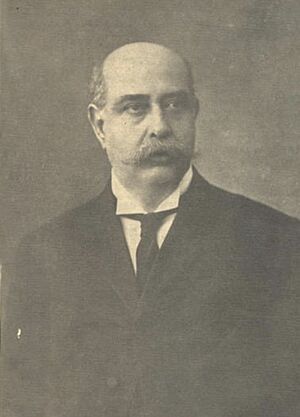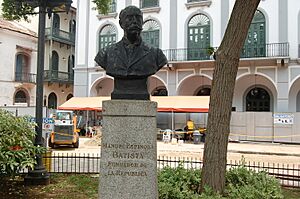Manuel Espinosa Batista facts for kids
Manuel Espinosa Batista (born September 12, 1857 – died November 27, 1919) was a smart and caring person from Colombia. He started as a pharmacist, which is someone who prepares and sells medicines. Later, he became a politician and worked hard to make Panama an independent country, separate from Colombia. Because of his efforts, he is known as one of the "Founders of the Republic" of Panama. He was also famous for his kindness and for helping others, which is called philanthropy.
Contents
Manuel's Early Life
Manuel Espinosa Batista was born in a city called Cartagena in what was then the Republic of New Granada. His father was Manuel Espinosa and his mother was Purificación Batista. When he was just 13 years old, he moved to the Isthmus of Panama. His relatives in Panama encouraged him to come.
Manuel started working in a pharmacy to earn money. He used his earnings to buy books and pay for his studies to become a pharmacist. He worked very hard and became an expert in medicines. In 1882, he opened his own pharmacy on Central Avenue in Panama City.
A few months later, his friend Jose Gabriel Duque got a special job from the government to start a National Lottery. Manuel helped him by becoming his guarantor, which meant he promised to support the project. Later, in 1899, Manuel became the president of the lottery company. Manuel was also good at business and invested in other successful ventures.
Manuel's Political Journey
Manuel Espinosa Batista began his political career by being elected to the city council. He served there from 1897 to 1898. He strongly believed that Panama should be its own country, separate from Colombia. This idea was supported by a group of people who wanted Panama to be independent.
This group included important figures like José Agustín Arango, Manuel Amador Guerrero, Nicanor de Obarrio, Ricardo Arias, Federico Boyd, Carlos Constantino Arosemena, Tomás Arias, and Manuel Espinosa Batista himself. Today, these people are honored as the "Founders of the Republic" of Panama. They often held secret meetings in the back room of Manuel Espinosa Batista's pharmacy to plan their actions.
On November 3, 1903, Panama finally achieved its separation from Colombia. That night, the local council announced the separation. The next day, they held a special public meeting called a cabildo in Panama City. During this meeting, Panama's independence was officially declared. The members of the council and the citizens who attended signed an important document to make it official.
The President of the council, Demetrio H. Brid, then chose a Provisional Government Junta. This was a temporary group that would lead the new country. The Junta included José Agustín Arango, Tomás Arias, and Federico Boyd. Manuel Espinosa Batista was chosen as a Deputy Member of this important group. This meant he could step in if one of the main members was not available. From November 9, 1903, to December 7, 1903, Manuel Espinosa Batista temporarily took the place of Federico Boyd in the Junta.
Helping Others: Manuel's Philanthropy
Manuel Espinosa Batista was not only successful in business and politics, but he also had a big heart. He was a true philanthropist, meaning he loved to help people.
He gave scholarships to many young boys who didn't have much money but wanted to study. He even sent some of them to study overseas. In 1885, a big fire destroyed many homes in Colón. Manuel donated money to help build new houses for the people who had lost everything.
He also gave money to improve Panama City. He helped pay for new streets and for the city's electric lighting. He even contributed to the system for collecting garbage, making the city cleaner. When he was a member of the city council, if there wasn't enough money for a city project, he would often pay for it himself.
Manuel also supported an orphanage run by the Salesians of Don Bosco. This orphanage later became the Don Bosco Technical Institute, which is a private Catholic school today. A small building at the institute is named after Manuel Espinosa Batista to honor his generosity.
Manuel's Family Life
Manuel Espinosa Batista was married to Elisa Remón Escobar. They had seven children together: María, Elisa, Isabel, Cecilia, Carmen, Raúl, and Manuel Espinosa Remón.
His wife, Elisa, along with Hortensia de Alfaro, helped organize the final show of the first art season in Panama in 1910. This special show raised money to help the elderly people living in the Bolívar home and the children in the orphanage.
Manuel's Lasting Legacy
Manuel Espinosa Batista passed away at the age of 62 on November 27, 1919. This was just one day before the 63rd birthday of President Belisario Porras.
To remember his important contributions, the National Assembly of Panama passed a law on December 16, 1924. This law called for a bronze sculpture, or bust, of Manuel Espinosa Batista to be made. It would have the words "Founder of the Republic" on it. Other busts were also commissioned for José Agustín Arango, Tomás Arias, and Federico Boyd, who were also members of the Provisional Government Junta. A bust of Manuel Amador Guerrero, Panama's first President, was also included.
These busts can be found in Independence Square, also known as Plaza Catedral, in Panama City. Later, busts of other members of the separatist movement were added to the square.
Today, a public school and an avenue in Panama are named after Manuel Espinosa Batista, ensuring that his legacy lives on.
See also
 In Spanish: Manuel Espinosa Batista para niños
In Spanish: Manuel Espinosa Batista para niños



